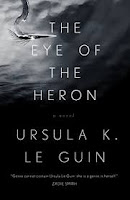While for some Ursula Le Guin is the writer of the Earthsea series, and for others the creator of the gender-bender Left Hand of Darkness, I don’t often get the impression many online have taken the effort to read bigger chunks of Le Guin’s expansive oeuvre. Though having read almost if not all the Hainish stories, written a thesis on Earthsea, and dabbled in random novels, collections, and stories, I personally feel as I’ve only climbed half of Le Guin mountain. But from my current view, I have the feeling The Eye of the Heron (1978) is something of a summary representation of Le Guin, as overt as it may be.
Working with the British model of the 18th and 19th centuries, The Eye of the Heron is based on the idea of sending society’s criminals and otherwise unwanted to another place. In the novella’s case, it is another planet far from Earth. Colonized in two waves, the first wave established societal and cultural order built around the traditional Western idea—leaders, police, gender roles, etc. The second wave, however, went for something different: rule by referendum and common sense, underpinned by pacifism ideology. Pushed outside the established city, these Shanti-towners trade the food they grow to the city dwellers for metal, technology, and other critical items. But while trade may be a cyclical, balanced area, authority is not. The city-dwellers considering the Shanti-towners a lesser but necessary people, relations take a turn for the worse when a large group of Shanti-towners make the decision to strike out across the mountains to establish a new town closer to the sea.
The novel is called “The Eye of the Heron” for the simple reason it does not follow a single or group of characters. Viewpoint shifting as plot requires, numerous people from all walks of life and positions within society come under the “bird’s gaze”, and in doing so help tell the broader tale of one period in the colony’s transformation. Le Guin’s main focus is clearly power (state vs the individual, ego, and gender within classic power structures), and non-violent resistance to authority. While presentation is often simplistic (more mythic than mimetic, which is Le Guin’s style), this area of focus comes into sharper relief for it. Le Guin’s thinking clearly spelled out for none to miss.
Thus, where The Dispossessed was a thought experiment around the idea of anarchy as a real form of government, The Eye of the Heron does something similar using Ghandi’s brand of passive resistance and group power. And as a true experiment should be, Le Guin feels to put the pieces on the table, understand them, then turn them loose to see what happens. When pitting passive resistance against hostile authority, there perhaps is only one inevitable result, which Le Guin does not shy away from, to her credit. The issue is, however: what to do when there is nowhere left to run?
With its focus on societal differences, power structures, feminism, and humanist ways of living, there may be no more distilled version of an “Ursula Le Guin novel” than The Eye of the Heron. Long novella/short novel, a lot of concepts are packed into the story—colonialism, feminism, pacifism, and others. Readers looking for deep characters and sophisticated plotting will be left disappointed, but again, those areas are not where Le Guin shines brightest.


No comments:
Post a Comment